ความแตกต่างระหว่างเครื่องจักร CNC และการพิมพ์ 3 มิติ
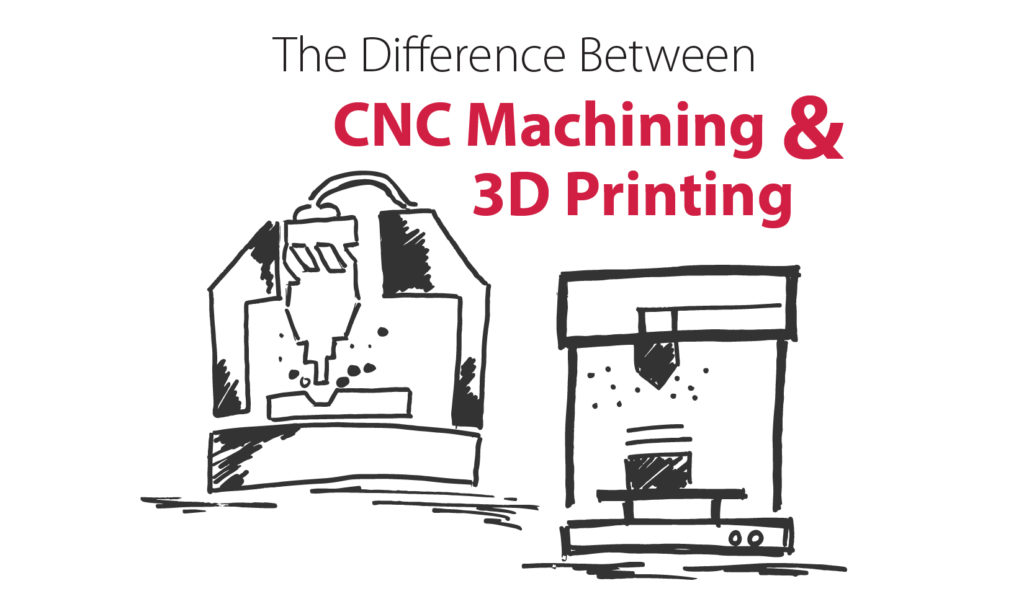
ในขณะที่เทคโนโลยีก้าวหน้าและปฏิวัติวิศวกรรมและเครื่องจักรคุณต้องการทราบว่าคุณกำลังใช้อุปกรณ์ที่ดีที่สุดและนำพาธุรกิจของคุณไปข้างหน้า ความก้าวหน้าบางประการเหล่านี้อยู่ในเครื่องจักรกลควบคุมตัวเลขด้วยคอมพิวเตอร์ (CNC) และการพิมพ์ 3 มิติ ทั้งสองทำงานกับวัสดุที่แตกต่างกัน แต่อันไหนดีที่สุดสำหรับความต้องการของคุณ?
CNC machining and 3D printing have similarities and differences, and each has unique benefits. They have varying circumstances where you would want to use them regarding cost and availability. Breaking down each manufacturing style will help you pick the best method for you and your business.
Their main differences occur in production, waste, scale, material availability and size of the parts.
SIMILARITIES BETWEEN CNC AND ADDITIVE MANUFACTURING (3D PRINTING)
CNC machining and additive manufacturing are both computer-controlled solutions to making products out of a given material. They’re both machines at the forefront of building technology safely and efficiently.
As machinists and engineers want to build a prototype, a part or a custom product, they can turn to one of these machines to do the job for them. As long as the machines have the design, you don’t have to worry about human error because the machines are automated. While this doesn’t mean issues don’t arise, there’s more consistency with production and less chance of injury.
There is some overlap with these two manufacturing methods. Some CNC machines can use STL and OBJ files, which 3D printers also accept.
CNC machinery is older than 3D printing and still has a stronger foothold in manufacturing. The form started in the 1940s and had molded to fit into the industry up to the present. 3D printing came along in 1986. It’s still relatively new and evolving to be more accessible and versatile. 3D printing can help in some areas of prototyping, but it’s not a replacement tool for CNC machining.
They’re not so much alternatives to the other as they are both aspects of the manufacturing world. They meet different demands and handle different materials and markets. CNC machines and 3D printing both have unique capabilities and constraints that suit them for specific jobs. As they fit their niches in the market, you’ll want to compare it to whatever industry you’re in.
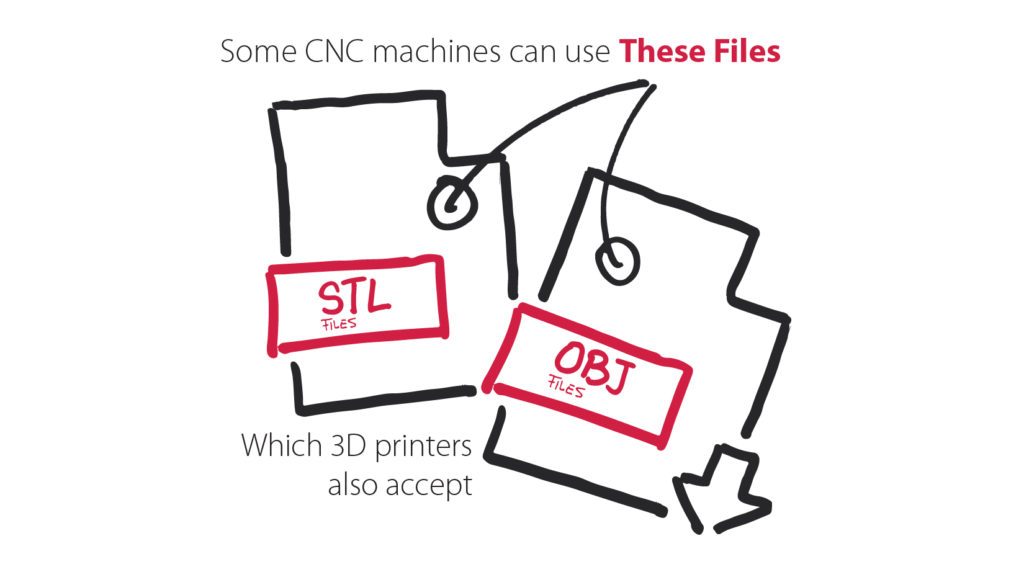
DIFFERENCES BETWEEN CNC MACHINING AND 3D PRINTING
From their building methods to what applications they can handle, CNC machining and 3D printing offer creative solutions in vastly different ways. Finding out their differences and strengths will help you find which one is right for you and your business.
3D printers are typically more efficient than traditional manufacturing. The printer uses the materials that make up the item it’s creating, whereas traditional manufacturing methods such as CNC Machining require more materials for the mold to work. On average, 3D printers produce less waste than traditional manufacturing methods.
However, when production is large-scale, traditional manufacturing methods have a distinct advantage. Assembly lines are faster than a 3D printer in mass production because printers build layer by layer. In the hours that it could take to 3D print a product, an assembly line could have mass-produced hundreds of the same product.
Additionally, 3D printers can only use the area of the printing bed for making parts. Large-scale parts might not fit in that space. While the parts can be broken down into smaller pieces 3D printers can build, that might not be cost-effective and will take time. Traditional manufacturing has the advantage of the assembly line’s labor and will be able to produce items on a larger scale. Future 3D printers could be able to build larger items, but not on the level of what CNC machines offer with regard to quality and quantity.
3D printers can manipulate different materials such as plastics, metals and polymers. However:
- Not all 3D printers can use these materials. It takes separate machines for each material.
- 3D printers cannot work with every material that traditional manufacturers use due to high melting points.
- Some projects might not be able to consider using 3D printers if they require specific materials that are incompatible with the printers.
Here is the bottom line — 3D printing won’t replace traditional manufacturing because of its disadvantages in mass-produced items.
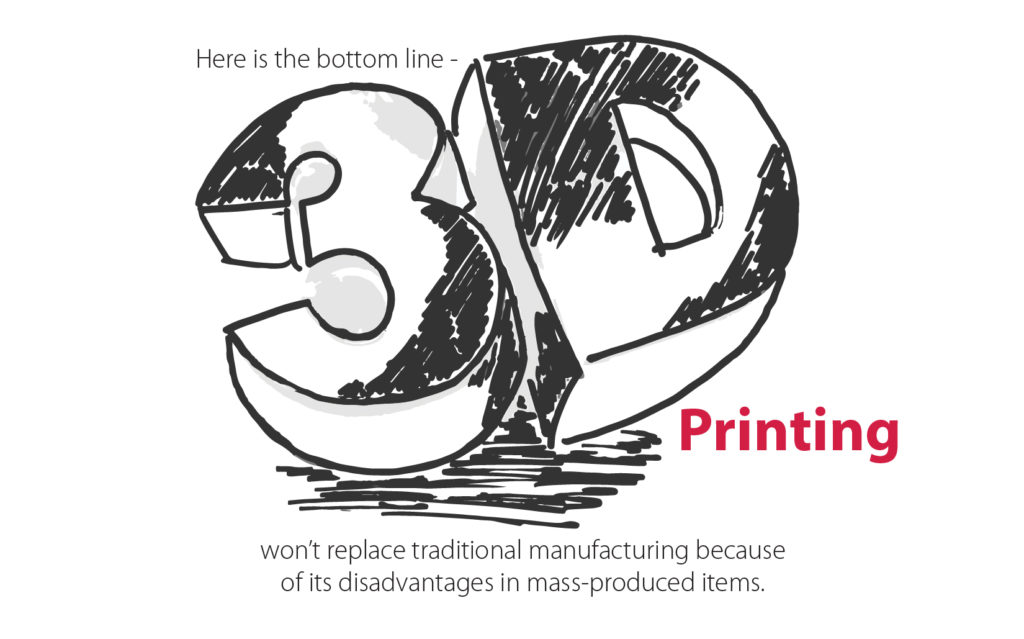
3D Printing vs. Traditional Manufacturing
CNC machining starts with a block of material and shapes it with a rotating tool. Following the program, it carves away excess until you have the finished product. This is the subtractive method because it’s taking away material.
3D printing layers on material in the additive method that builds your design. Both ways have pros and cons in terms of durability, precision and use of materials.
Material Usage for CNC and 3D
CNC machining works with a variety of materials. They can use:
- Metal alloys
- Woods
- Acrylic
- Modeling foam
- เทอร์โมพลาสติก
- Machining wax
CNC machines have heating systems that can manage heavy materials. These materials are used to build substantial parts for engines, aircraft and other machines. They need to be exact, dependable and durable. The cutting tools for the design might have to switch, but most tools are standardized to fit any CNC machine.
3D printing doesn’t have this variety, using materials like plastics or resins. They can’t produce items strong enough to withstand intense environments like airplanes or other machinery. Also, 3D printers can’t switch between materials. Certain 3D printers are for specific kinds of material.
3D and CNC Precision of Production
CNC machining is more precise and consistent than 3D printing because they have a higher tolerance for heat. 3D printers end up with distorted products when there’s too much heat. They can offer precision but cannot remain consistent. 3D printers are often regarded as more user-friendly than CNC machines, but when they malfunction, someone has to troubleshoot them because the fault means production of unusable products.
CNC and 3D Speed of Production
CNC is a faster solution than 3D printing. Automated CNC machines can work around the clock as long as they’re properly maintained. A project that could take CNC machining an hour would equate to a 3D printer taking hours to get the final product because it has to build the product layer by layer. A 3D printer’s pace might have to slow down during the process to get the design right. Different 3D printers could also be programmed with specific speeds that you can’t alter. It depends on the machine you use.
ผลิตภัณฑ์ที่พิมพ์ 3 มิติยังต้องใช้งานหลังจากสร้างเสร็จแล้ว ต้องล้างขัดและปิดผนึกผลิตภัณฑ์ก่อนที่จะใช้ผลิตภัณฑ์ สิ่งนี้สามารถขยายการทดสอบต้นแบบไปสู่ช่วงเวลาที่ยาวนานขึ้นโดยต้องรออีกมาก เครื่องพิมพ์ 3 มิติยังเป็นที่นิยมสำหรับสินค้าขนาดเล็กที่ผลิตขึ้นเอง แต่ถ้าคุณต้องรอให้สินค้าถูกสร้างขึ้นและยังคงทำงานหลังการพิมพ์จำนวนมากคุณจะเสียเวลามากก่อนที่จะสามารถเคลื่อนย้ายผลิตภัณฑ์ได้
ความคล่องตัวของเครื่องจักรสำหรับ CNC เทียบกับ 3D
เครื่อง CNC สามารถผลิตอุปกรณ์ติดตั้งเครื่องมือและชิ้นส่วนที่ออกแบบเองได้ มีการตั้งค่าคุณภาพที่หลากหลายเพื่อให้คุณสามารถสร้างต้นแบบที่มีการออกแบบที่หยาบกว่าในบางพื้นที่และสมบูรณ์แบบในส่วนอื่น ๆ เพื่อให้คุณสามารถทดสอบส่วนนั้นได้
When testing prototypes for a project, a CNC machine could quickly build a design so the developers can test it. 3D printers don’t have these kinds of options. It will slowly shape the design as it was programmed. Accuracy is key when constructing a final product, but when time is a constraint and you want to test some prototypes, 3D printers can slow down you and your project. Designs made for a CNC machine usually can’t be substituted with a 3D printer because the products are voluminous and it would take hours for a 3D printer to finish them.
Noise and Mess Produced by CNC and 3D
These differences relate to the subtractive and additive methods. CNC machining is much more noisy and messy than 3D printing because it uses a tool to cut away material. This creates noise and a lot of scrap metal or wood shavings. CNC machines cause a lot of vibrations, so they need to be in a space where they won’t bother anyone. 3D printing only uses the material it needs for the product. There’s little to no waste, and the printers don’t vibrate like a CNC machine.
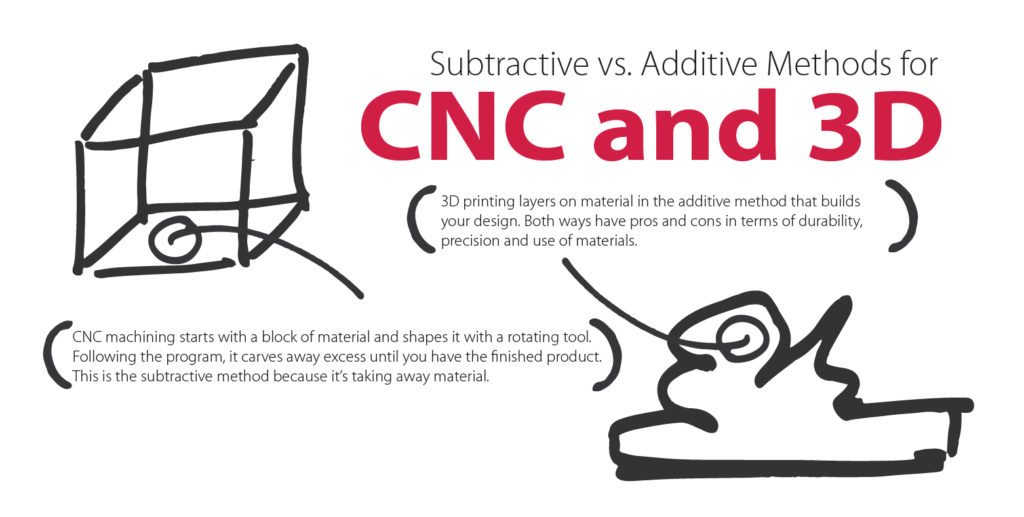
Applications for CNC and 3D
CNC machining can manufacture bigger products and can handle heat-resistance. 3D printing has more niche categories, such as printing food or working in space.
CNC Machining vs. 3D Printing
จากข้อมูลของ World Finance การพิมพ์ 3 มิติไม่ใช่วิธีการแก้ปัญหาที่สามารถแทนที่เครื่องจักรกลซีเอ็นซีได้ การพิมพ์ 3 มิติเป็นส่วนหนึ่งของโลกการผลิต แต่ไม่ใช่สิ่งประดิษฐ์ที่จะเปลี่ยนตลาดอย่างที่ทุกคนรู้
เครื่องพิมพ์สามมิติสามารถปรับปรุงการผลิตบางประการได้ แต่ไม่สามารถรองรับตลาดทั้งหมดได้เนื่องจากเครื่องจักรกลซีเอ็นซียังคงทำงานได้ดีกว่าในหลาย ๆ สถานการณ์ เครื่องจักรกลซีเอ็นซียังคงให้คุณภาพที่ดีกว่าเครื่องพิมพ์ 3 มิติราคาแพง
เครื่องพิมพ์ 3 มิติมีความได้เปรียบในการประหยัดเงินจากการซื้อแม่พิมพ์ราคาแพงสำหรับธุรกิจขนาดเล็ก พวกเขายังให้ข้อมูลเชิงลึกเกี่ยวกับรูปร่างและความสวยงามของผลิตภัณฑ์ แต่เมื่อการผลิตเพิ่มขึ้นและปัจจัยด้านเวลาก็ไม่สามารถรองรับเครื่องจักร CNC ได้
ประโยชน์ของ CNC MACHINING OVER 3D PRINTING
CNC machining fits with mass production. It can create many products in a shorter period, where 3D printing would take hours to create one product. That’s just one advantage of CNC. Let’s take a look at some others.
Prototyping Becomes Easier
CNC machines are better for prototypes that can withstand structural tests because they carve the design from the material. They can also build prototypes out of the exact material that will be used to make the final product.
Structural tests and alterations will be more accurate because they use the same material. This could speed up the production process because the changes will be to the design and not the material. 3D printers don’t fabricate prototypes with the structural strength, so they can’t conduct physical tests.
Prototype Integrity Improves
CNC machines don’t heat the material and reform it. The material stays stronger and has a better structural integrity than 3D printers, which have to heat the material to build the intended product. 3D printers might also have to add foreign materials to the mixture to be able to make the prototype, which CNC machines don’t need.
Surface Finish Advantage
CNC machines provide better surface finish than 3D printing because the materials don’t deform during the process. The rigid material and cutting action keeps the product together and has fewer chances for mistakes or deformations to occur. 3D printing has poorer surface finish. The material bends, warps or distorts because the material is layered heated plastic.
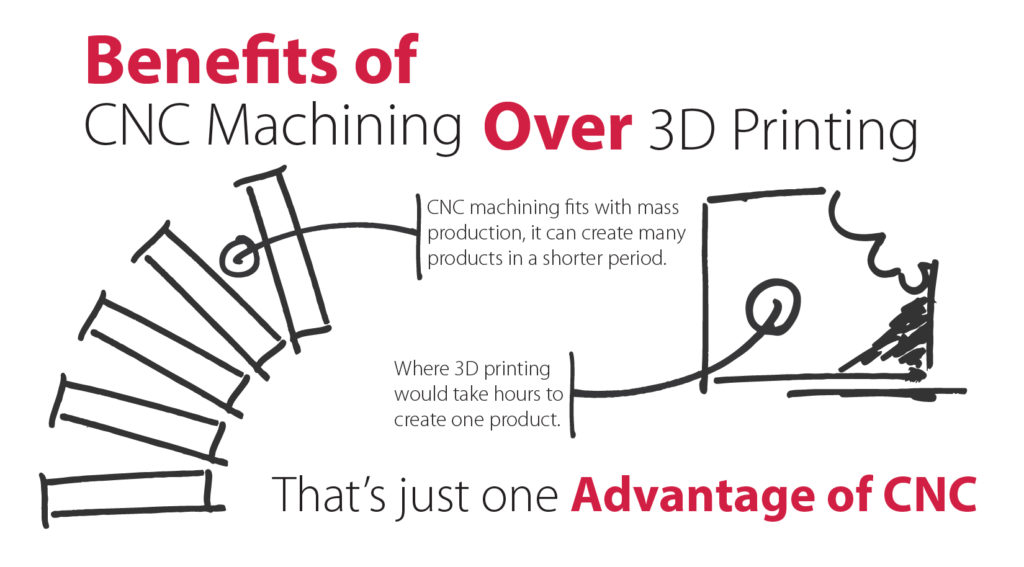
Tolerance Levels Rise
เครื่อง CNC ทำงานด้วยความแม่นยำสูงกว่าดังนั้นชิ้นส่วนจึงมีความทนทานที่ดีกว่าเครื่องพิมพ์สามมิติ เนื่องจากระดับความทนทานต้นแบบที่มีเพลาหรือเชื่อมต่อกับชิ้นส่วนอื่น ๆ จะมีคุณภาพสูงกว่าและมีแนวโน้มที่จะพอดีกับส่วนประกอบอื่น ๆ
ราคาและปริมาณอย่ากำหนดราคา
ต้นทุนการพิมพ์ 3 มิติขึ้นอยู่กับปริมาณวัสดุที่ต้องการ ปริมาณผลิตภัณฑ์ขั้นสุดท้ายไม่ได้กำหนดราคาสำหรับเครื่อง CNC การพิมพ์ 3 มิติจะไม่คุ้มค่ากับคำสั่งซื้อที่มากขึ้นและนี่คือสถานการณ์ที่เครื่องจักร CNC เติบโต
คุณภาพที่ชอบของ CNC
เลเยอร์ที่ใหญ่ขึ้นจากเครื่องพิมพ์ 3 มิติจะเร็วกว่า แต่ไม่ได้คุณภาพสูงเท่าเลเยอร์ที่เล็กกว่า หากคุณต้องการต้นแบบคุณมีทางเลือกที่จะทำให้มันเร็ว แต่มีคุณภาพน้อยกว่าเล็กน้อยหรือรอนานกว่าสำหรับต้นแบบที่มีคุณภาพดีที่สุดเท่าที่เครื่องพิมพ์จะมีให้ เครื่อง CNC มีตัวเลือกให้คุณเลือกความละเอียดสำหรับสินค้าของคุณ พวกเขาสามารถนำเสนอคุณสมบัติที่แตกต่างกันในระยะเวลาอันสั้นทำให้เหมาะอย่างยิ่งสำหรับการสร้างอย่างรวดเร็วและผลการทดสอบในทันที
ลดต้นทุน
หากคุณมีตัวเลือกในการเลือกวิธีการผลิตที่จะใช้สำหรับผลิตภัณฑ์ของคุณเครื่องจักรกลซีเอ็นซีมักจะถูกกว่าการพิมพ์ 3 มิติ
ติดต่อ Kaito mould Works, Inc. สำหรับความต้องการเครื่องจักรกลซีเอ็นซีของคุณ
CNC machining can build the parts you need for your business. Our expert machinists at Kaito Mould Works, Inc., will provide outstanding work that will help you reach your goals. We aim to help you get the correct part for your project.
Kaito Mould Works, Inc., provides services for custom machine building, precision parts machine and reverse engineering of components to give you the product you need promptly. We deliver exceptional CNC machining solutions for manufacturers in multiple industries. Our skill in specialization and dedication to our work will help you and your business stay on the cutting edge of the industry. We have the solutions you need. Get in touch with us today.
หากเราสามารถช่วยคุณในโครงการของคุณได้โปรดโทรหาเราที่0086-769-82821468 หรืออีเมลsales@kaitomould.com.



